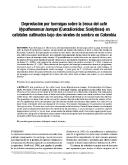| dc.description.abstract | Para determinar el efecto de la actividad depredadora de hormigas sobre la plaga del fruto del café, la broca Hypothenemus hampei, en dos niveles de sombra del cultivo, se llevó a cabo este estudio en Risaralda, Colombia. El experimento se realizó en siete fincas: tres con cafetal sin sombra de árboles y cuatro con cafetal con sombra diversificada. Las unidades experimentales fueron bolsas de malla que excluían y no excluían el paso de hormigas hacia adentro. El procedimiento se realizó dos veces, en época de lluvias y seca. El número de brocas fue significativamente menor en los tratamientos expuestos a hormigas para cada una de las fincas (P menor a 0,0001) este número fue además menor en fincas con sombra asociada (P menor a 0,05), y menor en la estación lluviosa (P menor a 0,05). Diez colonias de dos especies de hormigas encontradas dentro de pergaminos, Solenopsis picea y Tetramorium simillimum, fueron criadas en laboratorio. A cada una de estas colonias, se les expuso al mismo procedimiento usado en campo. S. picea, pero no T. simillimum, mostró alta actividad depredadora dentro de granos infestados. Los resultados muestran que existen posibilidades para la utilización de hormigas en el manejo integrado de la broca del café, sobre todo en fincas con sombra y en la estación lluviosa. In order to determine whether ants predate on the coffee berry borer Hypothenemus hampei in two shade levels this study was carried out at Risaralda, Colombia. The experiment was conducted in seven farms, three of them were coffee plantations without tree shade, and four were shaded coffee farms. The experimental units were mesh bags, which could exclude or not ant movement into the bag. The procedure was done twice, in the wet and dry seasons. Results in the field showed that the number of borers was significantly lower in treatment bags that did not exclude ant entrance this number was also lower in those farms with shade trees and during the wet season. Ten colonies belonging to two predatory ant species Solenopsis picea y Tetramorium simillimum were reared in the laboratory. Each of these colonies was subjected to the same treatment described above for the field. In the laboratory, S. picea, but not T. simillimum, showed high predatory activity, i.e. lower borer counts inside the infested coffee seeds. Our results suggest positive perspectives for using ants as biological control agents within an integrated pest management approach, especially in shaded coffee farms and during the wet season. | es_ES |


